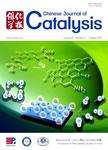Efficient electrocatalytic reduction of carbon dioxide to ethylene on copper–antimony bimetallic alloy catalyst
铜-锑双金属合金高效电催化还原二氧化碳制乙烯作者机构:Shanghai Key Laboratory of Green Chemistry and Chemical ProcessesSchool of Chemistry and Molecular EngineeringEast China Normal UniversityShanghai 200062China Beijing National Laboratory for Molecular SciencesCAS Key Laboratory of Colloid and Interface and ThermodynamicsCAS Research/Education Center for Excellence in Molecular SciencesInstitute of ChemistryChinese Academy of SciencesBeijing 100190China
出 版 物:《Chinese Journal of Catalysis》 (催化学报(英文))
年 卷 期:2020年第41卷第7期
页 面:1091-1098页
核心收录:
学科分类:081702[工学-化学工艺] 081705[工学-工业催化] 08[工学] 0817[工学-化学工程与技术] 080502[工学-材料学] 0805[工学-材料科学与工程(可授工学、理学学位)]
基 金:国家重点研发计划(2017YFA0403102) 国家自然科学基金(21573073,21733011)
主 题:Carbon dioxide reduction Ethyene Electrocatalyst Copper-antimony bimetallic alloy Synergistic effect
摘 要:The exploration of efficient electrocatalysts for the reduction of CO2 to C2H4 is of significant importance but is also a challenging ***-based bimetallic catalysts are extremely promising for efficient CO2 *** this work,we synthesize a series of porous bimetallic Cu–Sb alloys with different compositions for the catalytic reduction of CO2 to *** is demonstrated that the alloy catalysts are much more efficient than the pure Cu *** performance of the alloy catalysts depended strongly on the ***,the alloy with a Cu:Sb ratio of 10:1 yielded the best results;it exhibited a high C2H4 Faradaic efficiency of 49.7%and a high current density of 28.5 mA cm?2 at?1.19 V vs.a reversible hydrogen electrode(RHE)in 0.1 M KCl *** the best of our knowledge,the electrocatalytic reduction of CO2 to C2H4 using Cu–Sb alloys as catalysts has not been *** excellent performance of the porous alloy catalyst is attributed to its favorable electronic configuration,large surface area,high CO2 adsorption rate,and fast charge transfer rate.



